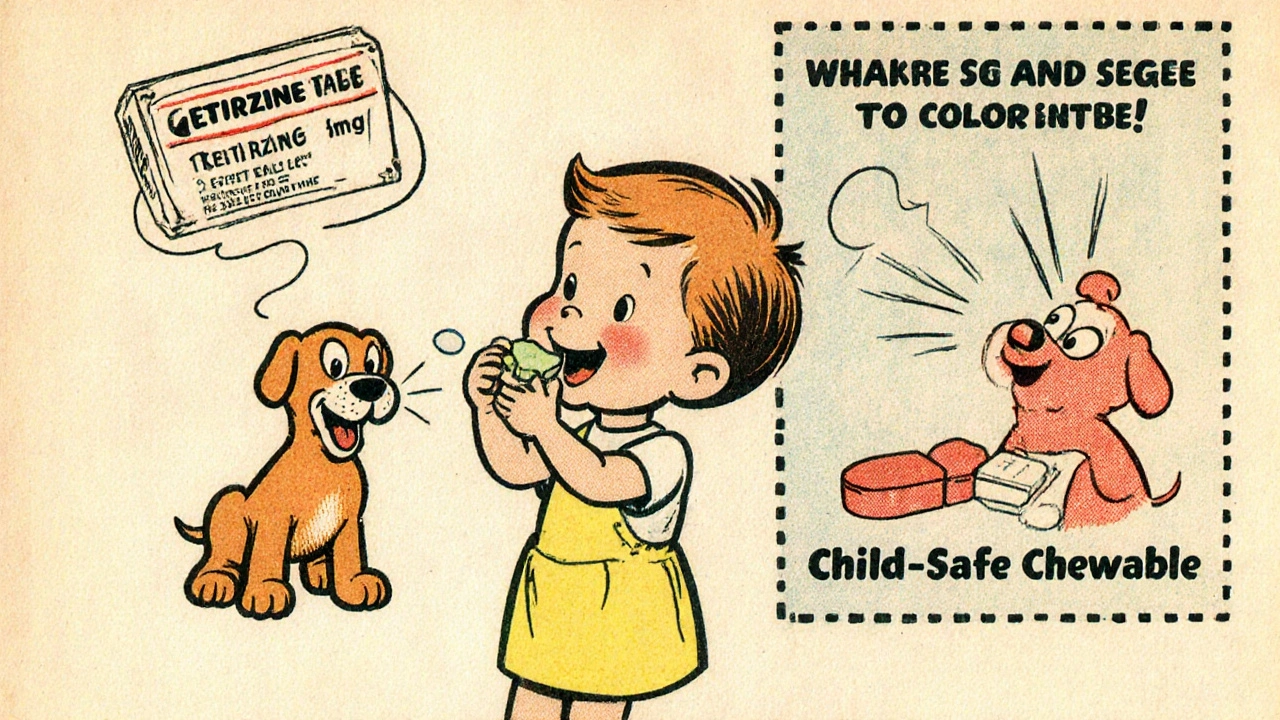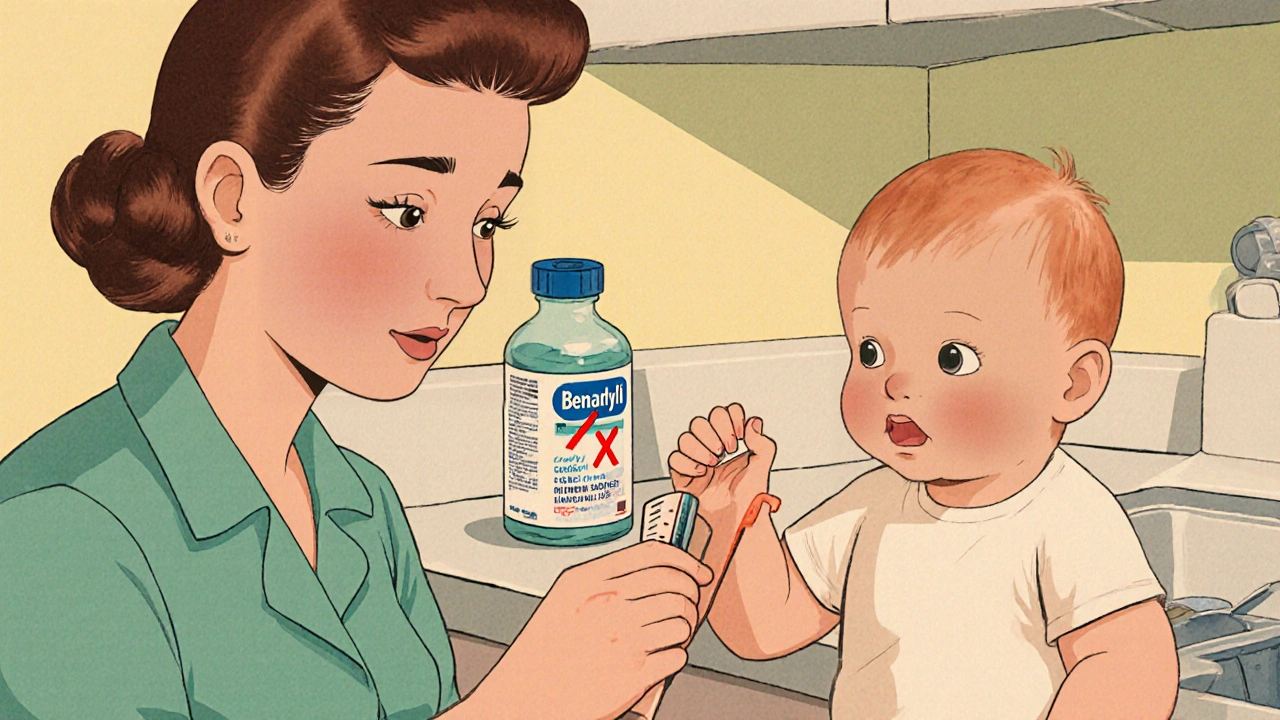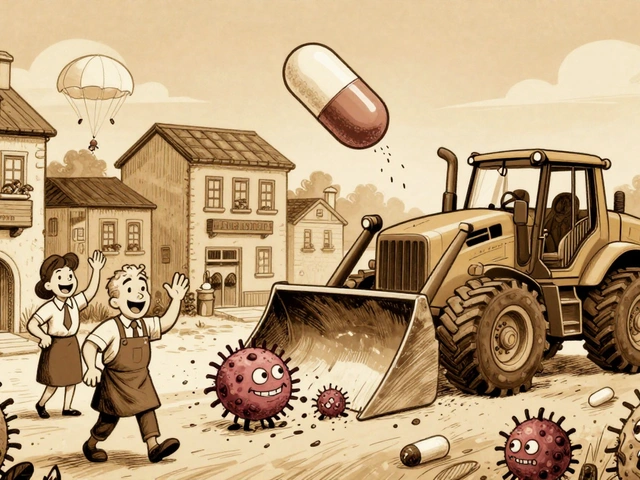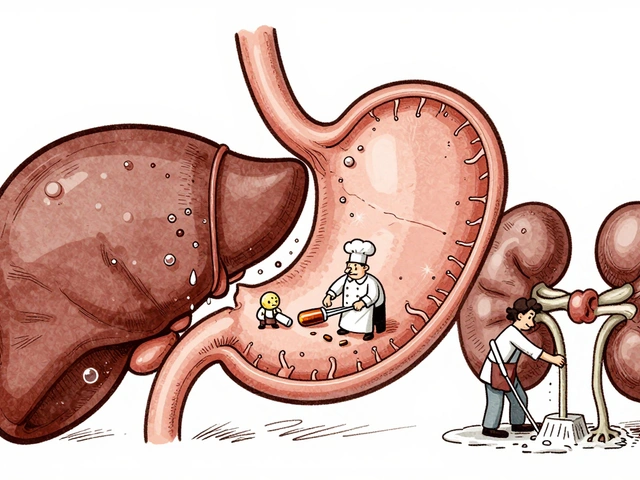When your child wakes up with a rash, sneezing nonstop, or swollen eyes, it’s natural to reach for an antihistamine. But giving your child the wrong dose-or the wrong kind-can be dangerous. Not all antihistamines are created equal, especially for kids. What works for an adult can overwhelm a toddler. The good news? There are clear, science-backed ways to use these medications safely-if you know what to look for.
Not All Antihistamines Are Safe for Kids
There are two main types of antihistamines: first-generation and second-generation. The difference isn’t just in the name-it’s in how they affect your child’s brain and body.
First-generation antihistamines like diphenhydramine (Benadryl) cross the blood-brain barrier easily. That’s why they make adults drowsy. In young children, that same effect can turn into dangerous side effects: extreme sleepiness, confusion, rapid heartbeat, dry mouth, or even trouble breathing. The FDA has warned since 2008 that diphenhydramine should not be used in children under 2 without a doctor’s direction. Even for kids aged 2 to 5, it’s not the first choice anymore.
Second-generation antihistamines like cetirizine (Zyrtec) and loratadine (Claritin) were designed to stay out of the brain. They work just as well for allergies but cause drowsiness in only 10-15% of children, compared to 50-60% with diphenhydramine. Studies show cetirizine causes less sedation than diphenhydramine and has fewer anticholinergic effects like dry eyes or urinary retention. For most kids with seasonal allergies, eczema, or hives, these are the safer, smarter options.
Dosing by Age: Exact Numbers That Matter
There’s no one-size-fits-all dose. Weight matters. Age matters. And the form of the medicine-liquid, chewable, tablet-changes everything.
For infants 6 to 11 months: Cetirizine is the only antihistamine with proven safety data in this age group. The starting dose is 0.125 mg per kilogram of body weight per day. For a typical 8 kg (17.6 lb) baby, that’s about 1 mg total per day. If symptoms persist, a doctor may increase it to 0.25 mg/kg/day. Never give cetirizine to a baby under 6 months unless a pediatric allergist specifically says to. Even then, it’s off-label and requires close monitoring.
For children 2 to 5 years: Cetirizine: 5 mg once daily (1 teaspoon of liquid, which is 5 mg/5 mL). Loratadine: 2.5 mg once daily (½ teaspoon of liquid, which is 5 mg/5 mL). Never use adult tablets or split them-children’s chewables come in 5 mg or 10 mg versions. Always check the label. Many parents assume all chewables are 5 mg. Some are 10 mg. One extra tablet can be an overdose.
For children 6 to 11 years: Cetirizine: 5 to 10 mg daily. Loratadine: 5 mg daily. You can give 10 mg once a day or split it into two 5 mg doses if needed. Most kids do fine with one daily dose.
For children 12 years and older: Standard adult dose: 10 mg of cetirizine or loratadine once daily.
Diphenhydramine, if used at all, should be strictly weight-based: 12.5 mg every 4 to 6 hours for a child weighing 38-49 lbs (about 17-22 kg). That’s 7.5 mL of liquid (12.5 mg/5 mL) or 1.5 chewable tablets. Never give more than 6 doses in 24 hours. And never use it to help your child sleep. That’s a dangerous habit that triples the risk of overdose in kids under 2.
Measurement Mistakes Are Deadly
One of the most common errors? Using a kitchen spoon.
Kitchen teaspoons vary in size by up to 50%. A “teaspoon” from your cupboard might hold 3 mL or 7 mL. The liquid medication bottle comes with a syringe or cup designed to deliver the exact amount. Use that. Every time. Even if you’ve used it before. Even if you think you remember how much.
Parents often grab the wrong bottle. They see “children’s allergy medicine” and assume it’s the same. But some products combine antihistamines with decongestants like pseudoephedrine. Those are not approved for children under 6. Giving them to a 3-year-old can cause high blood pressure, seizures, or heart rhythm problems.
Always read the active ingredients. If it says “Plus Decongestant,” “Cold & Allergy,” or “Nighttime Formula,” put it back. Only use plain antihistamines unless your doctor says otherwise.

When to Avoid Antihistamines Altogether
Antihistamines are not for every symptom.
Don’t use them for:
- Common colds-antihistamines don’t shorten illness or reduce congestion in kids under 6
- Sleep problems-using them as sleep aids increases overdose risk by 300% in children under 2
- Fevers or flu-like symptoms-these aren’t allergies
- Infants under 6 months-unless under specialist care
If your child has hives or a reaction after eating peanuts, bee stings, or shellfish, antihistamines can help-but they’re not enough. Anaphylaxis requires epinephrine (EpiPen) immediately. Call 911. Don’t wait to see if the antihistamine works.
What Experts Are Saying Now
Leading pediatric allergy groups like the American Academy of Allergy, Asthma & Immunology (AAAAI) and Boston Children’s Hospital now recommend cetirizine as the first-line choice for children 6 months and older. Dr. Eric Macy, a leading pediatric allergist, says: “Given that cetirizine 0.25 mg/kg/day has been shown to be safe and effective in infants 6 to 11 months old, I would recommend starting at 0.125 mg/kg/day and increasing if needed.”
Studies published in Pediatric Allergy and Immunology in 2020 confirmed cetirizine’s safety and effectiveness in babies as young as 6 months. In contrast, research shows first-generation antihistamines like diphenhydramine can cause cognitive delays and attention problems in young children-even at standard doses.
The American Academy of Pediatrics (AAP) and HealthyChildren.org warn that signs of overdose include extreme drowsiness, dilated pupils, blurry vision, confusion, racing heart, and agitation. If you suspect an overdose, call Poison Control at 1-800-222-1222 immediately.

What’s Changing in 2025?
The FDA is reviewing new data on cetirizine use in infants under 6 months. Clinical trials are ongoing, and approval for this age group could come by 2026. Until then, doctors may prescribe it off-label for severe cases, starting at 0.125 mg/kg/day.
Meanwhile, hospitals are updating their protocols. Boston Children’s Hospital revised its dosing charts in 2022 to include more precise weight-based ranges. Children’s Hospital Colorado now requires physician consultation for loratadine use in children 2-6 years.
Prescriptions for second-generation antihistamines have risen 17.3% each year since 2018. Why? Parents and doctors are learning the risks of older drugs. In 2023, 94.7% of pediatric allergists reported using second-generation antihistamines as first-line treatment.
What You Can Do Today
1. Check your medicine cabinet. Toss any old bottles of Benadryl labeled for children under 2. Don’t rely on memory-read the label.
2. Use only the measuring tool that came with the bottle. Never guess. Never use a kitchen spoon.
3. Choose cetirizine or loratadine. Avoid diphenhydramine unless your doctor says it’s necessary for a sudden, severe reaction.
4. Know the signs of overdose. Extreme sleepiness, confusion, fast heartbeat, or dry mouth are red flags. Call Poison Control immediately.
5. Don’t use antihistamines to make your child sleepy. It’s not safe, and it doesn’t fix the real problem.
Allergies are common. But giving the wrong medicine can be risky. With the right dose, the right drug, and the right tools, you can help your child feel better without putting them in danger.






12 Comments
bro i gave my kid benadryl for a rash last year and he slept for 12 hours straight like a zombie 😅 turns out i was lucky he didnt have a heart attack lmao
Thank you for this. As a mom of two with severe seasonal allergies, I used to reach for Benadryl out of habit. After reading this, I switched to Zyrtec and my 4-year-old hasn't been groggy all afternoon. Also, I finally bought the dosing syringe - kitchen spoons are a myth. 🙌
Same here. My cousin gave her 18-month-old diphenhydramine because the label said 'children's' and it was in the same aisle. Kid ended up in ER. Read the active ingredients. Always. No excuses.
Why are we even talking about this? Like, who lets their kid take antihistamines at all? Just get rid of the allergens. Or move to a desert. Or stop being so sensitive. It’s 2025, we have tech for this.
Oh. My. GOD. Did you SEE the part about 'cetirizine 0.125 mg/kg/day'? That’s not a dose - that’s a PhD thesis in pharmacokinetics wrapped in a baby bottle! Who has time to calculate this?! I just want my kid to stop sneezing without a calculator and a pediatrician on speed dial 😭
YES. This is the kind of info we need. No fluff. Just facts. I printed this out and taped it to my medicine cabinet. My 5-year-old’s allergies are way better now - and I’m not panicking every time he sneezes. You’re a lifesaver.
LOL so now we’re all supposed to be pharmacists? 🤡 Next they’ll make us memorize the half-life of loratadine before we can hug our kids. I’m just gonna give them sugar pills and call it ‘homeopathy’. At least I won’t accidentally poison them. 🙃
While the information presented is clinically sound and aligns with current evidence-based guidelines from the American Academy of Pediatrics, it is imperative that caregivers consult with licensed pediatric allergists prior to initiating any pharmacological intervention in pediatric populations under the age of two. The off-label use of cetirizine, while increasingly documented, remains subject to individual patient variability and requires careful risk-benefit analysis.
I wonder… if we’re so scared of giving kids meds, why are we okay with letting them live in a world full of dust, pollen, and processed foods that trigger allergies in the first place? Maybe the real problem isn’t the antihistamine - it’s the environment we’ve built for them.
Good stuff. I’m from the UK and we’ve been pushing second-gen antihistamines for years here. Still, I see parents in the supermarket grabbing the cheapest stuff with ‘kids’ on the label. Gotta be better. Thanks for the clarity.
So we’re just supposed to trust these studies? Who funded them? Big Pharma? The same companies that told us smoking was safe? Wake up. This is just another way to sell drugs to anxious parents. Let nature take its course. Kids used to get rashes and survive.
0.125 mg/kg/day? That’s a laughable oversimplification. You’re ignoring inter-individual metabolic variance, CYP2D6 polymorphisms, and the absence of pharmacokinetic data in low-birth-weight infants. This is not medicine - it’s algorithmic negligence wrapped in a pediatric pamphlet. You’re enabling parental complacency.
Write a comment